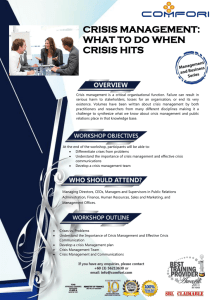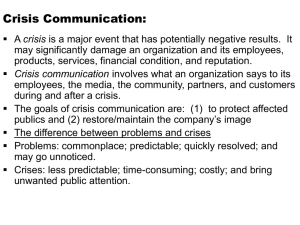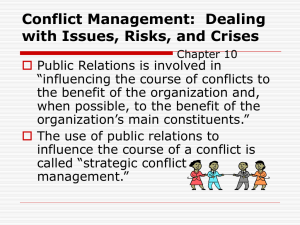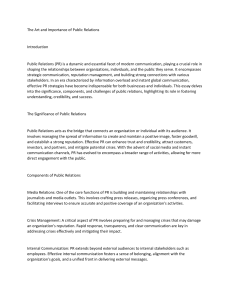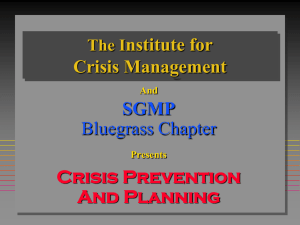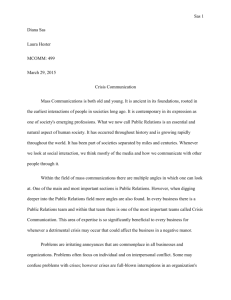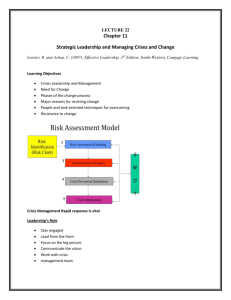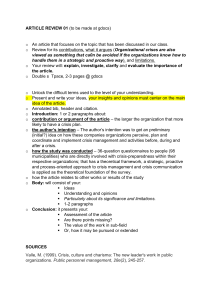Chapter 15
advertisement
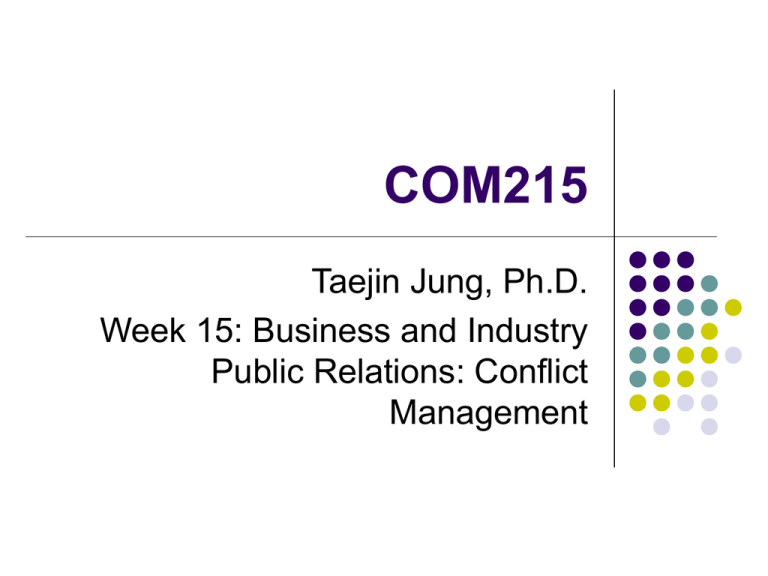
COM215 Taejin Jung, Ph.D. Week 15: Business and Industry Public Relations: Conflict Management Strategic Conflict Management Business Misconduct (cases) - Adelphia Communication Corp. Arthur Andersen Enron InClone Systems Inc. Martha Stewart WorldCom Inc. - Strategic Conflict Management - Public Relations professional must develop communication strategies to influence the course of conflicts to the benefit of the organization. - Served as “warning system” and “organization’s conscience” 1st Stage: Issue Management Proactive (↔reactive, crisis management) and systematic approach to - predict problem - anticipate threats - minimize surprises - resolve issues - prevent crisis “Sweat shop” labor of NIKE Process - Issue identification - Issue analysis - Strategy options - Action plan - Evaluation 2nd Stage: Risk Communication Any verbal or written exchange that attempts to communicate information regarding risks to public health, safety, and environment (e.g., food products, chemical spills, radioactive waste disposal…) “Variables” affecting risk perceptions 1. “Voluntary risks” tended to be accepted better than “risks with no control” (e.g., smoking vs. airline passengers) 2. The more complex situation, the higher the perception of risk (e.g., radioactive wastes vs. smoking) 3. Familiarity breeds confidence (e.g., proximity & risk perception) 4. Perception of risks increases when the messages of experts conflict 5. The severity of consequences affects risk perceptions Suggestions - Begin early and initiate a dialogue with publics - Actively solicit and identify people’s concerns - Recognize the public as a legitimate partner - Anticipate and prepare for hostility - Understand the needs of the news media - Always be honest, even when it hurts 3rd Stage: Crisis Communication Definition of “crisis” - An extraordinary event or series of events that adversely affects the integrity of the product, the reputation or financial stability or organization; or health or wellbeing of employees, the community, or the public at large. - Crises are forewarning situations that run the risk of escalating in intensity, falling under close media or government scrutiny, interfering with normal operations, jeopardizing organizational image and damaging a company’s bottom line. Example scenarios - A product recall; a plane crash; a very public sexual harassment suit; a market crash; a labor union strike “Smoldering” crises - Only 14 percent of crises are unexpected - With proper issue management, many of smoldering crises could be prevented Samples of Major Crises NIKE - Nike became the archetype of the company that lacked a social conscience due to its exploitation of workers in foreign plants. The value of the company stock went down, the media wrote numerous unflattering stories, and human rights activists had a field day. Microsoft - Caught in a battle with US Department of Justice and its competitors about monopolistic polices, received mostly unfavorable publicity throughout 1998 to 1999. McDonald - Got negative publicity when an 81-year old woman won a multi-milliondollar lawsuit against the company because she suffered third-degree burns from a scalding cup of coffee. Intel - The leading manufacturer of computer chips, faced a major credibility problem when flaws were found in its Pentium chip. How to Communicate during a Crisis Put the public first Take responsibility Be honest Never say, “No comments” Designate a single spokesperson Set up a central information center Provide a constant flow of information Be familiar with media needs and deadlines Be accessible Monitor news coverage and telephone inquiries Communicate with key publics 4th Stage: Reputation Management Definition - A collective representation of an organization’s past performance that describes the firm’s ability to deliver valued outcomes to multiple stakeholders - The track record of an organization in the public’s mind The three foundation of reputation - Economic performance - Social responsibility - Ability to deliver valuable outcomes to stakeholders “Most Admired Companies”
